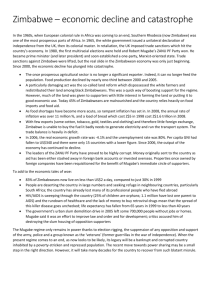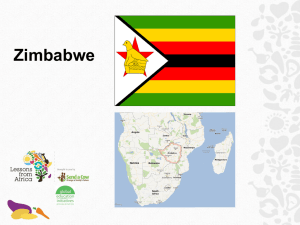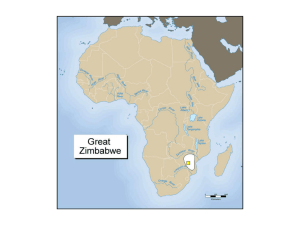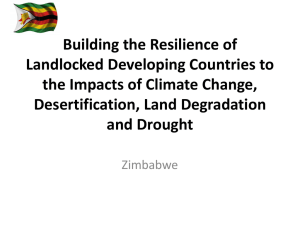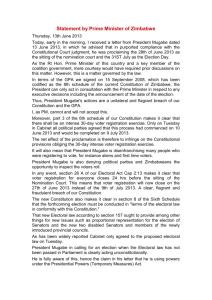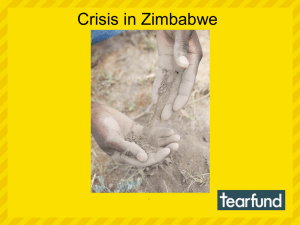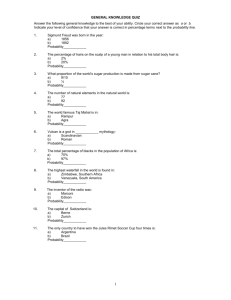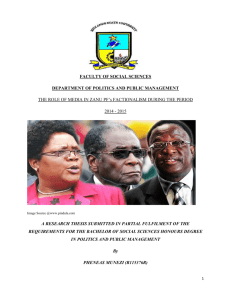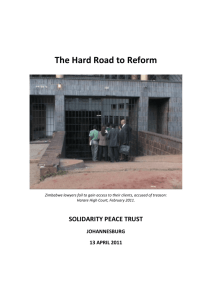The Great Betrayal Mugabes Gang and Genocide in
advertisement
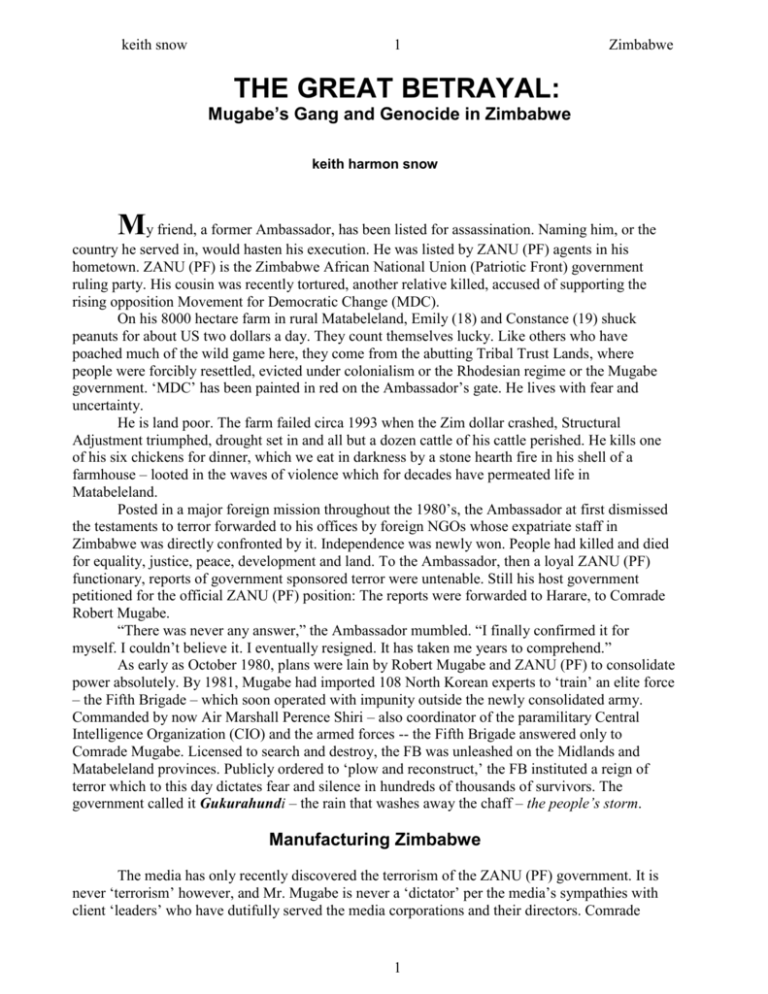
keith snow 1 Zimbabwe THE GREAT BETRAYAL: Mugabe’s Gang and Genocide in Zimbabwe keith harmon snow My friend, a former Ambassador, has been listed for assassination. Naming him, or the country he served in, would hasten his execution. He was listed by ZANU (PF) agents in his hometown. ZANU (PF) is the Zimbabwe African National Union (Patriotic Front) government ruling party. His cousin was recently tortured, another relative killed, accused of supporting the rising opposition Movement for Democratic Change (MDC). On his 8000 hectare farm in rural Matabeleland, Emily (18) and Constance (19) shuck peanuts for about US two dollars a day. They count themselves lucky. Like others who have poached much of the wild game here, they come from the abutting Tribal Trust Lands, where people were forcibly resettled, evicted under colonialism or the Rhodesian regime or the Mugabe government. ‘MDC’ has been painted in red on the Ambassador’s gate. He lives with fear and uncertainty. He is land poor. The farm failed circa 1993 when the Zim dollar crashed, Structural Adjustment triumphed, drought set in and all but a dozen cattle of his cattle perished. He kills one of his six chickens for dinner, which we eat in darkness by a stone hearth fire in his shell of a farmhouse – looted in the waves of violence which for decades have permeated life in Matabeleland. Posted in a major foreign mission throughout the 1980’s, the Ambassador at first dismissed the testaments to terror forwarded to his offices by foreign NGOs whose expatriate staff in Zimbabwe was directly confronted by it. Independence was newly won. People had killed and died for equality, justice, peace, development and land. To the Ambassador, then a loyal ZANU (PF) functionary, reports of government sponsored terror were untenable. Still his host government petitioned for the official ZANU (PF) position: The reports were forwarded to Harare, to Comrade Robert Mugabe. “There was never any answer,” the Ambassador mumbled. “I finally confirmed it for myself. I couldn’t believe it. I eventually resigned. It has taken me years to comprehend.” As early as October 1980, plans were lain by Robert Mugabe and ZANU (PF) to consolidate power absolutely. By 1981, Mugabe had imported 108 North Korean experts to ‘train’ an elite force – the Fifth Brigade – which soon operated with impunity outside the newly consolidated army. Commanded by now Air Marshall Perence Shiri – also coordinator of the paramilitary Central Intelligence Organization (CIO) and the armed forces -- the Fifth Brigade answered only to Comrade Mugabe. Licensed to search and destroy, the FB was unleashed on the Midlands and Matabeleland provinces. Publicly ordered to ‘plow and reconstruct,’ the FB instituted a reign of terror which to this day dictates fear and silence in hundreds of thousands of survivors. The government called it Gukurahundi – the rain that washes away the chaff – the people’s storm. Manufacturing Zimbabwe The media has only recently discovered the terrorism of the ZANU (PF) government. It is never ‘terrorism’ however, and Mr. Mugabe is never a ‘dictator’ per the media’s sympathies with client ‘leaders’ who have dutifully served the media corporations and their directors. Comrade 1 keith snow 2 Zimbabwe Mugabe, the ‘blue-eyed boy,’ is no longer ‘the darling of western multinational capital’ however and, therefore, recent coverage of the 2000 parliamentary elections in June has portrayed him in a mildly unfriendly light. The press has never explored the manufacture of “a nation where elections have been characterized by voter apathy” which, in any case, is only “in recent years,” and two decades of state-orchestrated terror is expediently cloaked in the media’s ostensible attention to “two months of intimidation and gerrymandering.” [International Herald Tribune, 6/28/00] Zimbabwe under Robert Mugabe provides a telling case study on the propensity of multinational capital to support the postcolonial rise and entrenchment of black dictatorships. It was critical to co-opt the global rise in black nationalism and expropriate liberation movements. Thus, while ever bemoaning the supposed losses they were simultaneously consolidating new gains. It was another capital coup, sold to the world by their media vanguard under the polished veneers of deceit. Hence the likes of Mobutu (1963-1997); Rawlings (1979-2000); Banda (?-?); Moi ( ?2000); Kuanda (1964-1991); Babangida (1987-1993); Eyadema (1967-2000); Biya (?-2000); Bongo (?-2000). Note the latter three – Togo, Cameroon and Gabon – remain in near total media whiteout. Note that Zimbabwe in 1998 and 1999 has returned record international banking profits. Typical of disingenuous and diversionary media portraits of Africa, one of the biggest articles on Zimbabwe in 2000 elections coverage focused not on the criminal opportunism of an entrenched client government gone sour, but on elephants tearing down an electrified fence to access crops. [International Herald Tribune, 6/22/00] Only the most privileged and their corporations have electrified fences here. This just four days before the polls, after yet another week of government orchestrated terror. “What is happening is not chaos, it is carefully orchestrated,” wrote human rights advocates in a 27-page chronology of violence from 14 February to 4 July. “It is state-organized violence. The issue also has little to do with land, legitimate issue though this is. The violence is about the first real threat to ZANU (PF) power in 20 years, the MDC.” The War of the Dogs Since the first British South Africa Company invasions of the late 1800’s, land has always been the issue for the disenfranchised masses of the Ndebele and Shona super-tribes. In 1893 a Ndebele defense force slaughtered the Alan Wilson patrol – an arrogant white squad dispatched by Cecil Rhodes – after the invaders pillaged Ndebele villages. By 1894 white settlers had taken over 100,000 head of Ndebele cattle. Chiefs were swindled. Mining, ranching and plantations spread like plague. Europeans destroyed crops and grain stores. Starvation and disease brought Ndebele survivors to eat the hides of slip aprons and sandals. Social institutions were expropriated, chiefs coerced, replaced, rewarded for state loyalty and native repression. Christian missionaries found fertile ground in destitute peoples divorced from everything safe and familiar. The colonists waged a propaganda campaign extolling the virtues of hostile lands on which natives were forcibly resettled. All the best land went to the whites. The Land Apportionment Act (1930) and Native Land Husbandry Act (1951) further institutionalized possessionary segregation and the division of Rhodesia into zones of exclusive white and black occupation. In 1974 the Rhodesian government executed ‘Operation Overload’ where, in three months and without warning, 46,960 members of 187 native homesteads were forcibly resettled into 21 ‘Protected Villages.’ People were repeatedly uprooted, forced to rebuild, promised the world but dumped on unknown land where nature, crowding, colonial de-stocking of cattle, disease, famine and coercive agrarian state policy prevailed. Taxes were collected at gunpoint. 2 keith snow 3 Zimbabwe By 1961 rising African Nationalism had swept the country into increasing non-cooperation and sabotage. To the arrogant whites, ‘Afro-Nat’ resistance was all quite improper, an affront to protocol, audacious native hooliganism. [Peter Godwin and Ian Hancock, Rhodesians ever Die: The Impact of War and Political Change on White Rhodesia, circa 1985]. Demonstrations were banned, movement restricted. Arrests, floggings, torture, forced confessions, extrajudicial executions, spotter aircraft and riot squads were justified to enforce whites-only hunting restrictions, land-grab policies, and the prosecution of white supremacy. “The communists had already started their propaganda,” wrote Ian Smith, in The Great Betrayal. “But our average black was not interested. Traditionally he was conservative and satisfied with the manner in which things were progressing.” Smith could not have been further out of step with ‘his average black.’ The Zimbabwe African People’s Union (ZAPU) emerged in 1961 under Joshua Nkomo; ZANU in 1963 under Robert Mugabe. [There were many other early leaders in both parties, many of whom were eventually assassinated.] From Zambia ZAPU and ZANU – both banned 1964 – orchestrated armed incursions against the Ian Smith regime and the emergent Rhodesian Front (RF). The first major armed rebel action (1962) provoked a RF police search and destroy operation, which netted some 97 rebels. Huge dogs were used. It is remembered as ‘the war of the dogs.’ Guerrilla War Early guerrilla incursions led to arrests and imprisonments, which crippled the nationalist struggle and drove it underground. The RF’s Unilateral Declaration of Independence (UDI) against Britain in 1965 increasingly brought the abrogation of basic human rights. African Nationalism in turn found support in an unholy alliance with international capital. “The farmers, small local manufacturers and skilled workers had developed a common interest in exploiting and segregating the Africans. This coalition certainly formed the support basis of the RF in 1962. It came together to fight multinational capital, represented by the mining companies, finance houses and major secondary industries, and which opposed rigid segregationist and supremacist policies in favor of the greater incorporation of blacks as wage earners, consumers and middle managers.” [G. Arrighi, in Essays on the Political Economy of Africa, New York, 1973]. To Ian Smith, this was ‘the great betrayal.’ “Why were the internal affairs of black African one-party dictatorships off the agenda at Commonwealth [UK] Ministerial Conferences,” he bemoans, revealingly, “and Rhodesia’s internal affairs on the agenda?” It was a lost cause. As nationalism turned to guerrilla war the increasingly intransigent RF resorted to new heights of dispossession, secret hangings and grotesque forms of torture. The RF infiltrated and bombed guerrilla bases in Zambia and Mozambique. The elite RF Selous Scouts staged horrific killings of civilians to alienate civilian support for ZIPRA and ZANLA -- the armed wings of ZAPU and ZANU -- guerrillas, who retaliated in turn against collaborators real and imagined. The civilians of Matabeleland suffered particularly harshly. The Selous Scouts successfully infiltrated supply networks, impregnated clothing and spiked food and drinks with lethal chemical poisons, causing guerrillas to turn on civilians. The late 1970’s saw napalm and anthrax used, campaigns of biological warfare now well documented. Livestock and people died en masse: In one district in Matabeleland alone an estimated 10,000 cattle died and 1200 people were treated for anthrax poisoning. Infected victims continued to seek treatment into the 1980’s [See Violence and Memory, notes to p. 145]. 3 keith snow 4 Zimbabwe “The number of cases was wholly unprecedented and the epizootic persisted for an unusually long period; the pattern of distribution was abnormal as disease was confined to national borders and within these only affected Africans. People testified to having seen planes dropping a white powder on fields and pastures; others saw soldiers sprinkling ‘small pills’ into water sources which killed fish and poisoned cattle [Alexander et al: Violence and Memory].” By 1979 some 800-900 people were dying monthly in an increasingly unpopular and unsuccessful war costing the RF some US$ 1.1 million per day. There were over 9000 prisoners in Rhodesian jails. Defeat was imminent. Still the legacy of colonialism, the inequities of white supremacy and its authoritarian legal structures, the preferential access to loans and massive government subsidies gave whites a monopoly on land. In 1978 some 6000 white farmers produced agricultural sales worth $R 332 million; 680,000 African farmers produced only $R 24.6 million. Corporations like Liebigs and Lonrho owned estates of over 1 million acres. Under UDI and the international sanctions placed on Rhodesia to 1980, the state prospered like never before. Transnational corporations masqueraded as domestic firms to evade sanctions. Military expenditures benefited external players: In 1979 a squadron of U.S. Augusta Bell 205 ‘Huey’ helicopters were acquired in an illicit deal through the U.S.-Israeli partnership. Royal Dutch Shell busted sanctions to fuel the RF war. Twenty Cessna ST337B reconnaissance planes manufactured in France under US license were delivered. U.S., UK and other companies sold heaps of landmines to all parties; they endure to maim and kill innocent civilians today [Human Rights Watch publication on landmines in Southern Africa, 1999]. Sanction busting was untransparent however: Many more interests participated. While guerrilla war won widespread public support, ZIPRA and ZANLA guerrillas faced each other as enemies. ZANLAs and their backers targeted ZIPRAs; battles erupted at guerrilla camps in Zambia and Mozambique. Antagonism persisted under the cease-fire agreement with the RF (12/21/79) and into the post-Independence violence, the Gukurahundi. Tribalizing the Polity The Lancaster House Agreement, which brokered the transition to majority rule, contained clauses which entrenched the rights of white Rhodesians and corporations. Both black and white Rhodesian officials hostile to nationalism retained government posts, to the angst of locals who expected their replacement -- if not punishment. Draconian decrees proscribing basic freedoms prevailed against citizens for years to come. “Adoption of the Lancaster Constitution meant that Rhodesian businessmen and those African elites aspiring to become capitalists had ten long years to discover and influence each other before the new state could legally take any steps which might by chance lay the foundation for socialism.” [Dr. T. Mahoso, “Zimbabwe Reconciled to Rhodesia,” MOTO, April 1992: 6] Big players like Roland ‘Tiny’ Rowland, John Brodencamp, Billy Rautenbach (a guns runner who today owns some 150 companies in 11 African countries, British Virgin Islands and the US), Lonrho, the Oppenheimers and deBeers threw their weight behind ZANU (PF) as Robert Mugabe distilled victory out of the 1980 elections. The overwhelming ZANU (PF) win was seen as remarkable, given the huge rural power base of ZAPUs Joshua Nkomo: The elections were felt to be grossly rigged. Intimidation and violence orchestrated by ZANU (PF) in rural areas -- which characterized the 2000 elections – had its genesis in 1980. Hundreds of prominent ZAPU supporters were rounded up after the 1985 elections and disappeared. Matabeleland was hardest hit. Repression against ZAPU/ZIPRA continued after the cease-fire agreement. Demobilization from the war saw RF forces at the helm, where like ZANLAs, most retained their arms and freedom of movement. ZIPRA guerrillas were treated like a defeated army: They were disarmed and 4 keith snow 5 Zimbabwe confined; busloads of demobilizing guerrillas were attacked by air, fired upon by police. ZANLAs retained their heavy artillery, subsequently used against ZIPRAs, who did not. Facing significant persecution, still most ZIPRAs complied with demobilization and by June 1980 ZIPRA regulars following ZAPU leadership rounded up hundreds of uncooperative ZIPRA guerrillas, who were subsequently imprisoned and held for years. Comrade Mugabe and his cadres soon set out to manufacture a ‘dissident’ and/or ‘ZAPU’ and/or ‘Ndebele’ conspiracy, as justification for repression. As with the history and importance of ZAPU/ZIPRA during the liberation struggle, ZANU (PF) set to work to expropriate the history of ZAPU/ZIPRA in the postcolonial era. The Gukurahundi would be similarly denied. “The nation was imagined after 1980,” wrote the authors of the newly released Violence and Memory, which retells the history of Matabeleland, “so as to exclude the western third of the country. In this way men and women in Matabeleland who were committed nationalists found themselves in conflict with the nation state. Zim nationalism turned out to be authoritarian rather than emancipatory, and we are under no illusions that had ZAPU rather than ZANU won the 1980 elections, things would have been very different. At the level of its leadership, Zim nationalism in 1980 was commandist; both parties were equally committed to the one-party state and the executive presidency.” [Jocelyn Alexander, JoAnn McGregor and Terrence Ranger, Violence and Memory: One Hundred Years in the ‘Dark Forests’ of Matabeleland, James Currey, 2000: p. 84] The newly independent Zimbabwe clearly faced hostile internal and external forces. South African commandos sympathetic with the RF continued to penetrate and attack military targets. Former RF soldiers, aberrant ZIPRAs and ZANLAs, criminals and opportunists all contributed to instability. However, most all insecurity lumped under the category ‘dissidents’ by the ZANUP(PF) government was subsequently attributed to ZAPU, ZIPRA and to the Ndebele people. As persecution against ZIPRAs intensified, hundreds of ex-ZIPRAs in the newly incorporated Zimbabwe National Army (ZNA) deserted. Thousands of ZIPRAs fled to Dukwe refugee camp in Botswana where they faced deportation and conscription into a secret South African backed ‘Super-ZAPU’ commando force. Super-ZAPU targeted white farmers and ZIPRAs and operated briefly only in Matabeleland. Regular ZIPRAs were confused and deceived by SuperZAPU: They recognized ZIPRA leadership, but in the field Super-ZAPUs no longer behaved with the strict professionalism or ethics of ZIPRA. ZIPRAs eventually awoke to the Super-ZAPU game and ruthlessly drove them out. However most people targeted as ‘dissidents’ were merely ex-ZIPRAs facing a systematic campaign of extermination who were driven back into the bush. It was not the ZANU (PF) government which they fought, but the imperative of life or death. Unlike the liberation struggle, the citizenry did not support them, since the government used ‘dissident’ activities to justify a campaign of terror and the public blamed this on the ‘dissidents.’ From early independence, ZANU (PF) increasingly politicized tribe, polarizing the Shonas and the Ndebeles. While ZIPRAs in the 1970’s had enjoyed much support in Shona areas, in the 1980s they found hostility. If Shonas reported ‘dissident’ activity in Shona areas they were rewarded; Ndebeles who did the same in Matabeleland were shot. Speeches by Mugabe and ZANU (PF) officials, and propaganda by their monopoly on the press, exaggerated the scale and frequency of ‘dissident’ violence, which, often enough, was manufactured by ZANU (PF). Known arms caches were suddenly ‘discovered,’ coincidentally timed to support ZANU (PF) claims of a rising conspiracy. ZAPU/ZIPRA properties were confiscated, ZAPU leadership purged from office, jailed, exiled. Prime Minister Mugabe sowed suspicion and tribal animosities at every turn. Detention camps were set up in Matabeleland prior to 1983. ZIPRAs and ZAPUs were increasingly tortured and ‘disappeared.’ True ZANLA dissidents sowing insecurity in Shona areas – a much more significant threat – were disproportionately attended. Matabeleland had suffered unbearable violence, decades of discrimination and war. The worst was yet to come. 5 keith snow 6 Zimbabwe Gukurahundi Dominated by former ZANLA guerrillas, the Fifth Brigade was given unlimited powers and total license to exterminate ‘dissidents’ without question or explanation. Uniquely uniformed, marked by red berets, they predominantly targeted innocent civilians. No one was too young or too old. While civilians in just two districts of Matabeleland attributed 45 murders from 1981 to 1987 to ‘dissidents,’ the Gukurahundi killed in the tens of thousands. In January 1982, Matabeleland North was invaded, cordoned off, curfewed, and punished. According to Patson Sibanda, they came to his village at dawn. They abducted all males, door-to-door, and loaded them on buses at gunpoint: They were never seen again. Patson was tipped off; he fled to Botswana. Patson points to the borehole where they beat his mother when she went for water. They targeted ZAPUs, government officials, even ZNA regulars on leave. Clinics and schools were attacked, teachers brutalized, medical staff beaten and warned not to treat rising local casualties. They set up permanent and mobile bases, occupied water boreholes, shops – anyplace people had to go – and they carried lists naming people for assassination. Violence was intentional, systematic, and premeditated. It was also random, indiscriminate and meaningless. Women and children and the elderly were beaten for pursing their daily lives. People were herded – frog-marched under constant abuse – to all night indoctrination rallies, sometimes lasting for days, forced to sing and dance, and were beaten or killed for the most trivial ‘offenses.’ They were pulled from buses, forced to dig their own graves in front of loved ones, humiliated and shot. An old man summoned from across a field was beaten for not moving fast enough. Villages were torched, families burned alive in huts. Bodies were dumped in mine shafts as often as they were left to rot in public. People were killed if they sought to recover their dead, funerals were forbidden. Mass graves proliferated and these remain testaments to the horrible and perverse incidents f violence and torture, geographical apparitions scarring the landscape and haunting the people’s psyches, all too real and current. Government trucks sometimes returned to massacre sites to collect the skeletons and the propensity – if not policy -- to tamper with, suppress or destroy evidence persists to the present. While some police and officials worked to shield the populace, most turned a blind eye or participated. Some were targets themselves. Civilians recognized Fifth Brigade soldiers as the same ‘dissidents’ that had abused them, demanding food, the night before; people followed ‘dissidents’ into the bush where they watched them change into government uniforms. In testimony taken from thousands over the past fifteen years, victims and witnesses repeatedly stressed the soldiers’ own words: Their orders were to ‘wipe out the people in the area’ and ‘kill anything that is human.’ [Catholic Commission for Justice and Peace, Breaking the Silence, Building True Peace: A Report on the Disturbances in Matabeleland and the Midlands, 1980-1988, Legal Resources Foundation, 1997.] Rape was policy, it was both public and private and it often preceded killings. Pregnant women were publicly bayoneted and gutted, families forced to watch, as soldiers talked about killing the Ndebele unborn. At schools girls were raped sometimes 20 to 30 at a time and then forced to have sex with the boys as soldiers watched. Widespread rape was interpreted as a systematic attempt to create a generation of Shona children. As early as March 1983 government officials were petitioned to stop the carnage. Representatives from the Catholic Commission for Justice and Peace personally delivered evidence of atrocities to Prime Minister Mugabe. Official policy then vacillated between encouragement of atrocities and denial. Patterns of violence clearly changed however, though repression remained 6 keith snow 7 Zimbabwe equally lethal. In January 1984 the Fifth Brigade was deployed in Matabeleland South where, under suffocating curfew and restrictions of movement, and the telltale repression, starvation was further adopted as a strategy. With less than 200 true dissidents in the region, some 400,000 civilians suffered horrendously. Fifth Brigade atrocities proliferated most from 1983 to 1985. Paramilitary forces – the elite CIO, Police Internal Security Intelligence (PISI) -- ZANU (PF) youth and ZNA forces complemented the Fifth Brigade operations with notorious terrorism of their own. While the Fifth Brigade was withdrawn in 1986, these ZANU (PF) agents continued to arrest, torture, interrogate and ‘disappear’ into and throughout the 1990’s, to the present. Rather than changing the allegiance of the public, repression hardened them against the ZANU (PF) government. Former ZAPA leaders like Joshua Nkomo incorporated into the ZANU (PF) government after 1988 reverted to policies of silence or of ‘not opening old wounds,’ preaching the rhetoric of unity in public, feathering their own nests backstage. While there were an estimated 400 dissidents at the height of 1980’s ‘insecurity,’ most were captured, killed or exiled, and only 122 dissidents turned themselves in after the Unity Accord -between ZANU (PF) and ZAPU leadership -- and the government Amnesty of 1988. With not less than 10,000 killed (many people count over 30,000), thousands more were disappeared, tens of thousands were severely tortured, hundreds of thousands were subjected to some kind of physical or psychological abuse. The impact of ZANU (PF) violence cannot be overstated: “Merely to threaten to make people,” wrote Human Rights advocates in 2000, “is a powerful weapon against defenseless people who have personal memories of witnessing executions and being tortured by this government in the recent past.” The New Face of Socialism The rhetoric of liberation and independence translated early into new schools and clinics, but ‘progress’ proliferated most significantly on paper, and this subsumed any popular land redistribution. Neocolonial policies partnered with the self-interest and cronyism of ruling elites to further usher the interests of western capital and the white minority into the 1990’s. Enter Structural Adjustment: Unemployment bloomed; real wages fell; the Zim $ was devalued; expenditures for education, food and health care – once promised free for all – dried up as Mugabe’s gang of thieves followed their marching orders in shiny new Mercedes Benz sedans. Foreign-controlled mining, banking and big tobacco (US) reaped unprecedented profits. Meanwhile the goods and services grew ever more inaccessible to the ever poorer black masses. Note that there is a direct and significant link between poverty, mass rape, and bloodletting against women, and the lack of basic health care to the spread of the AIDS pandemic in Africa. In the major ongoing ‘AIDS in Africa’ propaganda front of the world media, AIDS is almost entirely dissociated from these factors and attributed almost universally to heterosexual intercourse. The emergent front was launched with a six-part series in the New York Times which began with a huge article of August 6, 1998. Focused on AIDs and Zimbabwe, this huge feature totally diverted attention from root causes: terrorism, underdevelopment, mysogyny and dictatorship. Top-down international conservation and development programs were ‘overwhelmingly endorsed’ in rural Matabeleland – by people who were terrified into a consensual silence by ZANU (PF) cadres, informants and police around them. Many programs only further dispossessed them of their land. Government propaganda and backslapping foreign donors delineated wildlife protection areas even as Mugabe plead that there was no land available for redistribution. Coercion and arrests 7 keith snow 8 Zimbabwe followed resistance to programs dictating that infrastructure be relocated to accommodate wildlife – this where such basic resources were mostly absent. Further evictions persisted in efforts to ‘conserve’ forests. Neglect, discrimination and conflict in Matabeleland combined to leave health care mostly inaccessible. A massive malaria epidemic struck in 1996, killing hundreds (at least): Some 52,932 people treated for malaria strained already meager health services. Meanwhile, from 1992-1997 a massive Z$ 1.7 billion was paid out from the War Veteran’s Compensation Fund, a scandal where, for example, many supposed ‘War Vets’ were born after Independence and Mugabe’s brother-inlaw Reward Marufu won a settlement for a fraudulent claim of a 90 % disability. In 1997 some 62 poor families were evicted as the Gokwe North Rural District Council officials razed their homes: These were people who had already been forcibly evicted under the Kariba Dam project (1950s): By 1997, their rebuilt lives were blocking a proposed Safari project by a white Zimbabwean. Huge farms previously acquired for land redistribution have gone to government ministers and ZANU (PF) leaders. “Historical inequities and colonial legislation, government looting, favoritism and skewed resettlement policies remain the major stumbling blocks in the poor’s struggle for land in Zimbabwe,” wrote ZimRights, commenting on the ongoing Mugabe ploy to manipulate and influence the 2002 presidential elections through the waves of recent farm invasions. Back to the Futureless Costing Zimbabwe some US$ one million per day, Mugabe’s gang in August of 1998 dealt themselves into the gold, diamonds and cobalt free-for-all in the former Zaire -- it’s a perverse farce to call it the Democratic Republic of Congo -- in exchange for supporting Kabila’s ouster of Mobutu. Under the veil of the international media and with the support of the dubious Organization of African States (OAU), he has been assisted in bluffing 13 million people in a country where education is so lacking that some do not yet associate malaria with mosquitoes. UN Secretary General Kofi Annan has been silent on the Zim crises: Son Kojo Annan is director of Air Harbor Technologies, partnered with Leo Mugabe, for the controversial multimillion dollar development of Harare’s New International Airport. [FYI: Kojo Annan is also linked to Sutton Investments, a Nigerian firm which in 1999 won the six million pound contract to monitor the UN oil-for-food program in Iraq: “UN Chief Under Fire,” Financial Gazette, 5/4/00]. When a reporter for the London Guardian [or Observer: I will email the proper citation ASAP] tried to break the story of the Gukurahundi in 1983 it was crushed by Tiny Rowland and Lonrho corporation. Suppression and the story itself became hot topics in England: Even Prince Charles was aware of it. It has otherwise remained off the media agenda. The Reagan, Bush and Clinton administrations certainly knew about it. UNHCR, UNIFEM, CIDA (Canada) and Lutheran World Federation all ran the Dukwe refugee camps in Botswana (1980-1988). Reagan and Ian Smith people had a history, and they remain(ed) close. David Coltart, 2000 elections winner of an MDC parliamentary seat, in 1992 traveled to Europe and Washington and petitioned government and UN officials and US Senators (Nancy Kassebaum and others) to withhold IMF and World Bank loans pending accountability for the Gukurahundi and ongoing violence. He was ignored. Government soldiers disguised as landless squatters and ‘War Vets’ continue to prosecute farm invasions as this article goes to press. Much of what should be the people’s land is not controlled by ‘white farmers’ but also by huge corporations. Roadblocks, curfews, beatings and intimidation in rural areas and high-density suburbs of Harare persist. Soldiers wearing the uniforms of the Fifth Brigade, and others in the telltale red berets, have been seen in rural areas. New lists for assassinations have been drawn up. The message is clear. The tactics are all too familiar. 8 keith snow 9 Zimbabwe Mugabe’s fall from grace may be an issue of his gang’s infringing on other international criminals operating in the DRC (like Barrick Gold: a George Bush, Brian Mulroney, Senator Howard Baker enterprise). It may be an issue of the expedience of greater ‘democracy,’ the imperatives of market or raw material access and Zimbabwe’s transition to a new stage of predatory capitalism. The MDC will most likely support this process. Mugabe’s days are numbered. Many people are calling for recognition of the Gukurahundi and prosecution of Mugabe’s Gang for crimes against humanity. Mugabe continues to play his part in the great betrayal of the African masses and the US media continues to provide cover. In any case, Emily and Constance will keep on shucking peanuts for peanuts in Matabeleland. ~ end 9
